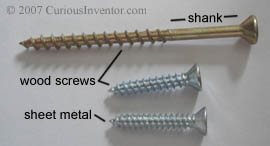Basic Difference between Metal Screws and Wood Screws
Fasteners such as screws are extensively used in hardware industries and they are available in huge varieties and patterns, so as to meet various industry requirements. Many people carry a notion that screws are all the same. But if you visit any online hardware supply store, such as Mutual Screw and Supply, you would learn that these fasteners are available in various designs and each one of them features distinct functionality.
 You can only settle down for a particular hardware item, which meets your requirement, provided you understand the basic difference between various screws, say metal screws vs wood screws. Many people would assume that the basic difference lies in their materials. But this is not entirely true, as the metal rivets can also be used in wooden and fiber glass surfaces and the wood fasteners can also be used in surfaces other than furniture. However, their main difference lies in their features and designs.
You can only settle down for a particular hardware item, which meets your requirement, provided you understand the basic difference between various screws, say metal screws vs wood screws. Many people would assume that the basic difference lies in their materials. But this is not entirely true, as the metal rivets can also be used in wooden and fiber glass surfaces and the wood fasteners can also be used in surfaces other than furniture. However, their main difference lies in their features and designs.
Threads
You can site a major difference in their threading pattern. These two rivets are threaded differently. While the sheet metal fasteners are benumbed and are threaded on the entire body, the wooden rivets are comparatively soft and feature a tapered shank. The threading on metal ones is available up to 3 inches and the wooden ones feature threading up to 1 inch. The sheet metal screws flaunt a straight shank along-with a finer threading pattern other than the wooden rivets, which are threaded only two-thirds of the way up.
Pitches
Pitch refers to the number of threads per inch. The metal rivets feature number of pitches than the wooden ones, which indicates that they feature a coarser pitch. In case of the wooden screws, the top portion is often not threaded, thereby enabling the rivet to be popped up from the surface.
Uses
The metal fasteners can also be used in furniture pieces, whereas wooden screws are not ideal to be used in metal surfaces. The metal screws are ideal for self-tapping. (Self-tapping means that the fastener can create its own threading as it advances through the material). These self-tapped rivets are used in plastics, fiber-glass and plywood, whereas in wooden screws, self-tapping is not possible. These fasteners are used in outdoor building structures such as decks and fences.
Leave a Reply